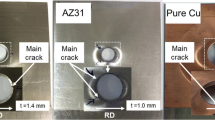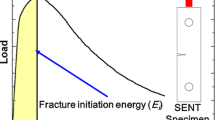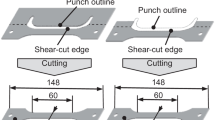Abstract
Failure in sheared-edge stretching often limits the use of advanced high-strength steel sheets in automotive applications. The present study analyzes data in the literature from laboratory experiments on both the shearing process and the characteristics of sheared edges. Shearing produces a surface with regions of rollover, burnish, fracture, and burr. The effect of clearance and tensile strength on the shear face characteristics is quantified. Higher strength, lower ductility steels exhibit an increase in percent fracture region. The shearing process also creates a zone of deformation adjacent to the shear face called the shear-affected zone (SAZ). From an analysis of data in the literature, it is concluded that deformation in the SAZ is the dominant factor in controlling failure during sheared-edge stretching. The characteristics of the shear face are generally important for failures during sheared-edge stretching only as there is a correlation between the characteristics of the shear face and the characteristics of the SAZ. The effect of the shear burr on shear-edge stretching is also related to a correlation with the characteristics of the SAZ. In reviewing the literature, many shearing variables that could affect sheared-edge stretching limits are not identified or if identified, not quantified. It is likely that some of these variables could affect subsequent sheared-edge stretching limits.






Similar content being viewed by others
References
B.S. Levy and C.J. Van Tyne, Failure during Sheared Edge Stretching, J. Mater. Eng. Perform., 2008, 17, p 842–848
M. Nakata, K. Uematsu, and S. Koseki, Shear Deformation Properties of Ultra High Strength Steel Sheet, Drawing the Things to Come, Proceedings of the International Deep Drawing Research Group (IDDRG) 2006 Conference, A.D. Santos and A. Barata da Rocha, Eds., INEGI—Instituto de Engenharia Mecânica e Gestão Industiral, Leça do Balio, Portugal, 2006, p 527–534
A. Koinieczny and T. Henderson, On Formability Limitations in Stamping Involving Sheared Edge Stretching, SAE Paper No. 2007-01-0340, Steel Innovations, Fatigue Research, Sheet/Hydro/Gas Forming Technology & Advanced High Strength Steel Development SP-2103, SAE International, Warrendale, PA, USA, 2007, p 41–50
B. Bösh, F. Birzer, and K. Hayashi, Material Consumption in Fine-Blanking, Advanced Technology of Plasticity, Vol II, The Japan Society For Technology of Plasticity, Tokyo, Japan, 1984, p 815–820
M. Murakawa, Burr-Free Shearing, Advanced Technology of Plasticity, Vol II, The Japan Society For Technology of Plasticity, Tokyo, Japan, 1984, p 805–814
S.B. Lee, “Microstructural Influences on the Fracture Behavior of Multi-Phase Sheet Steels”, PhD. Thesis, Colorado School of Mines, 2005
S.B. Lee, J.G. Speer, D.K. Matlock, and K.G. Chin, Analysis of Stretch-Flangeability Using a Ductile Fracture Model, Proceedings of Third International Conference on Advanced Structural Steels, H.C. Lee, Ed., Seoul, Korea, 2006, p 841–849
Z. Milosevic and F. Moussy, Simulation of Sheared Edge Behavior in Stretch Flanging by a Modified Fukui Test, Advanced Technology of Plasticity, Vol II, K. Lange, Ed., Springer-Verlag, Berlin, 1987, p 697–702
S. Scheib, P. Satkulvanich, and T. Altan, Examining Edge Cracking in Hole Flanging of AHSS: Part II, Modeling of Blanking, Stamp. J., 2008, 20(7), p 22–23
R. Hambli and S. Richer, Damage Mechanics Approach in Crack Growth Simulation during the Fine Blanking Process, Int. J. Mater. Product Technol., 2003, 19, p 466–478
S. Kalpakjian, Manufacturing Processes for Engineering Materials, 1st ed., Addison-Wesley Publishing Company, Reading, MA, 1984, p 390–393
S. Golvashcenko, A. Ilinich, and L. Smith, “Trimming of Advanced High Strength Steels”, SAE Paper No. 2009-01-1178
B. Carlsson, P. Bustard, and D. Eriksson, “Formability of High Strength Dual Phase Steels,” Paper F2004F454, SSAB Tunnplåt AB, Borlänge, Sweden, 2004
J. Chintamani and S. Sriram, Sheared Edge Characterization of Steel Products used for Closure Panel Applications, SAE Paper No. 2006-01-1589, Innovations in Steel Sheet Products & Processing & Steel Bar Products, SAE International, Warrendale, PA, USA, p 143–148
R.D. Adamczyk and G.C. Michal, Sheared Edge Extension of Cold Rolled Sheets, J. Appl. Metalwork., 1986, 4, p 157–163
R.G. Davies, Edge Cracking in High Strength Steels, J. Appl. Metalwork., 1983, 2, p 293–299
C. Held, R. Schleich, M. Sindel, and M. Liewald, Investigation on Advanced Forming Limit Prediction Techniques for High Strength Steels, Material Property Data for more Effective Numerical Analysis, Proceedings of the International Deep Drawing Research Group (IDDRG) 2009 Conference, B.S. Levy, D.K. Matlock, and C.J. Van Tyne, Eds., 2009, p 461–470
N. Lazaridis, Private communication, November, 1986
R.J. Comstock, D.K. Scherrer, and R.D. Adamczyk, Hole Expansion in a Variety of Sheet Steels, J. Mater. Eng. Perform., 2006, 15, p 675–683
C. Chiriac and G. Chen, Local Formability Characterization of AHSS – Digital Camera Based Hole Expansion Test Development, Best in Class Stamping, Proceedings of the International Deep Drawing Research Group (IDDRG) 2008 Conference, N. Asnafi, Ed., Swedish Deep Drawing Research Group, Olofström, Sweden, 2008, p 81–91
Acknowledgments
Partial support for this work from the Advanced Steel Processing and Products Research Center at Colorado School of Mines is gratefully acknowledged.
Author information
Authors and Affiliations
Corresponding author
Appendix A: Effect of Shear Burr Position on Failure During Stretching
Appendix A: Effect of Shear Burr Position on Failure During Stretching
Shear burr position (up or down) is generally thought to affect limit strain in sheared-edge stretching. The burr up position indicates that the burr is on the top surface of a sheet relative to the punch, while burr down represents the opposite condition. The purpose of this appendix is to show the conditions for which shear burr position affects limit strain in sheared-edge stretching.
Data on limit strain in sheared-edge stretching using circular holes are available for the burr up and burr down conditions for conical and spherical punches (Ref 1). The steels that were investigated are 1.4 mm thick 50XK, 590R, DP590, DP780, DP980, and TRIP 780. Prior to edge stretching, 10 mm holes were pierced at 1.1, 6.4, 13.5, and 20.8% clearance.
The experimental data on limit strains is subject to experimental variation. Comparing the difference between limit strains in the up and down positions increases experimental variation. Thus, in analyzing the effect of burr position, the differences in limit strains for the up and down positions are averaged for all clearances for each of the steels in the experiment.
The averaged difference values for a spherical and conical punch are shown in Table A1. Table A1 shows that for the spherical punch, there is no consistent effect of burr position on limit strain. In contrast, for a conical punch the data show that limit strain for burr in the up position is consistently less than for burr in the down position and that the difference decreases as tensile strength increases.
Regression analysis is used to quantify the effect of burr down minus burr up on limit strain determined using a conical punch.
where δ is the difference in limit strain for burr down minus burr up and TS is tensile strength in MPa, b 0 = 0.204 ± 0.027, and b 1 = −0.000184 ± 0.000036. The R 2 value is 0.86, the sample size is 6, and deviations from the regression line are reasonably random.
Equation A1 can be explained using the following logic. As a hole is expanded with a conical punch, the plane of the sheared edge moves from the vertical plane toward the horizontal plane. In the horizontal plane, the burr up position is on the outside surface. Once the free edge is vertical, the circumferential strain component on the outer surface can be 20 to 40% greater than that on the inner surface. While the strain gradient between the inner and outer surface decreases as testing progresses, there will still be a significant strain gradient from the outer to the inner surfaces. This analysis is supported by experimental observations that fracture initiates on the outer edge of a hole expanded with a conical punch (Ref 20).
In contrast, with a spherical punch, the free edge remains nearly in the horizontal plane, and strain gradients between the top and bottom surfaces are minimal. Thus, the position of the shear burr is only important when there is a significant strain gradient between the top and bottom surfaces of a sheet. In production operations, the strain gradient between the top and bottom surfaces is minimal for flanging or for expanding an interior cutout such as the window openings on a body side outer. In contrast, for extruded holes, strain gradients between the top and bottom surfaces of a sheet can be significant.
It should also be noted that the International Organization for Standardization (ISO) test for hole-expansion uses a conical punch. Thus, the effect of burr position can be observed in hole-expansion tests using the ISO test.
Rights and permissions
About this article
Cite this article
Levy, B.S., Van Tyne, C.J. Review of the Shearing Process for Sheet Steels and Its Effect on Sheared-Edge Stretching. J. of Materi Eng and Perform 21, 1205–1213 (2012). https://doi.org/10.1007/s11665-011-9997-x
Received:
Published:
Issue Date:
DOI: https://doi.org/10.1007/s11665-011-9997-x




